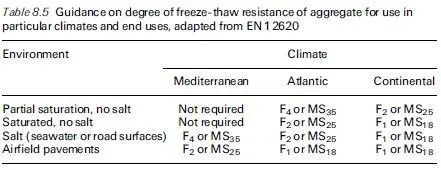The future achievement of durable concrete may increasingly be based on the use of durability design models and performance-based specifications. These models relate the resistance of the structure, R…t†, to the deterioration mechanism `load’, S…t†, on the structure. The design constraints may be framed in a number of ways such as the `Lifetime Safety Factor Method’, `Intended Service Period Design’, and the `Lifetime Design Method’. For example the problem could be framed in the following probabilistic form:
 The mathematical solutions to the problem of design for durability are not straightforward because allowance must be made for the multitude of variables involved and their statistical distributions. Mathematical modelling of freeze- thaw behaviour is as yet not fully developed. Thus durability design for freeze- thaw resistant concrete through the use of mathematical models in service life prediction is not currently possible. Nevertheless the three comparative tests for freeze-thaw performance, outlined in CEN/TS 12390-9, are paving the way for the introduction of performance-related design methods with respect to durability.
The mathematical solutions to the problem of design for durability are not straightforward because allowance must be made for the multitude of variables involved and their statistical distributions. Mathematical modelling of freeze- thaw behaviour is as yet not fully developed. Thus durability design for freeze- thaw resistant concrete through the use of mathematical models in service life prediction is not currently possible. Nevertheless the three comparative tests for freeze-thaw performance, outlined in CEN/TS 12390-9, are paving the way for the introduction of performance-related design methods with respect to durability.
Formulation of valid mathematical models of the freeze-thaw phenomenon is complicated by the unpredictable pattern of damaging cycles and the difficulty of verifying the apparent influence of mix parameters in laboratory tests with service life experience of structures in service. Freeze-thaw durability failure is event-driven, as illustrated in Fig. 8.15, and does not follow a predictable time- related pattern. The level of damage per cycle can vary greatly, the rate of damage will vary from year to year depending on climatic conditions and the dwell period between series of cycles could vary greatly. Laboratory test methods are generally conducted with daily cycles in a range from ‡20ëC to ÿ20ëC but performance in these trials cannot be readily translated to field experience due to the influence of temperature and degree of saturation.
Nevertheless Fagerlund (1997, 2004) has outlined possible approaches for durability design based on the degree of saturation. The basis of the models is that concrete fractures at a critical degree of saturation.




